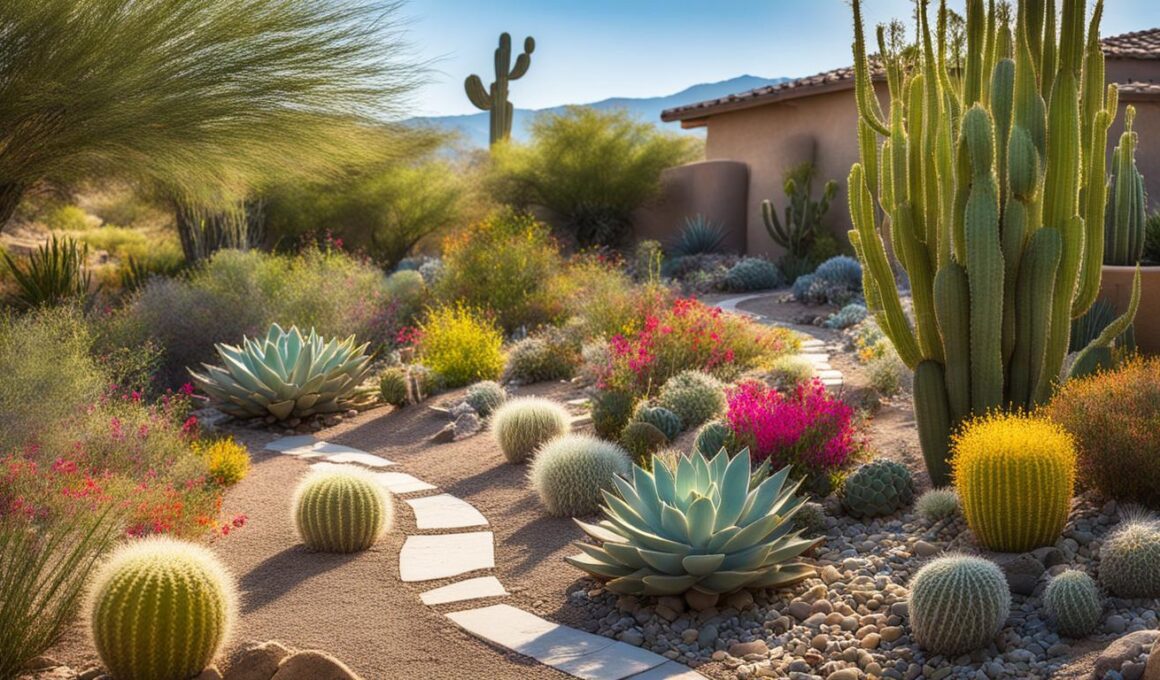Xeriscape landscaping, also known as xeriscaping, is a method of landscaping designed for areas prone to drought or where water conservation is important. By using minimal water and incorporating techniques such as grouping plants by their water needs, using mulch, and choosing drought-tolerant plants, xeriscape landscaping helps conserve water and promotes a healthy garden. One of the key principles of xeriscaping is the reduction of lawn grass, which often requires excessive watering. Instead, xeriscape gardens focus on plantings, ornamental grasses, and alternative ground covers. By following the principles of xeriscape landscaping, homeowners can create a water-wise garden that is both aesthetically pleasing and sustainable.
Key Takeaways:
- Xeriscape landscaping is a water-conserving method designed for areas prone to drought or where water conservation is important.
- By incorporating techniques such as grouping plants by their water needs and using drought-tolerant plants, xeriscape landscaping helps conserve water.
- Xeriscape gardens focus on reducing lawn grass and instead emphasize plantings, ornamental grasses, and alternative ground covers.
- Following the principles of xeriscape landscaping can help create an aesthetically pleasing and sustainable water-wise garden.
- Xeriscape landscaping is a practical and environmentally friendly approach to gardening.
Essential Tips for Xeriscape Landscaping
Planning is essential for successful xeriscape landscaping. Consider the topography, exposure, and soil of your garden to create planting zones and group plants based on their water needs. Use native plants that are adapted to the local climate and require less water.
Reducing or eliminating turf grass is a key aspect of xeriscape landscaping. Instead of traditional lawn grass, opt for alternative ground covers or drought-tolerant grass varieties. This not only reduces water consumption but also minimizes the need for mowing and maintenance.
Group plants with similar water requirements together to minimize water usage. This allows for more efficient irrigation and prevents overwatering certain plants. Implementing drip irrigation systems is highly recommended as it helps control water usage and directs water only to plants that need it the most.
Improving soil drainage and incorporating mulch can further assist with water retention and weed suppression. Ensure that your garden’s soil has proper drainage to prevent waterlogging, and use organic mulch to help retain moisture in the soil. Proper watering, weeding, pruning, and pest management are also important for the overall health and longevity of your xeriscape garden.
Benefits of Planning and Implementing Xeriscape Landscaping
- Xeriscape landscaping helps conserve water by utilizing drought-tolerant plants and minimizing water-intensive features like lawns.
- It reduces maintenance efforts and costs associated with traditional gardening, such as mowing, watering, and fertilizing.
- By using native plants and creating planting zones, xeriscape gardens can better adapt to and withstand local climate conditions.
- Implementing proper irrigation systems like drip irrigation helps control and optimize water usage in the garden.
- Xeriscape landscaping promotes sustainability and environmental stewardship by minimizing water waste and the use of harmful chemicals.
“Xeriscape landscaping is not only about water conservation but also about creating a beautiful, environmentally friendly garden that enhances the aesthetic appeal of your outdoor space.”
By following these essential tips for xeriscape landscaping, you can create a water-wise garden that not only conserves water but also enhances the beauty of your outdoor space. Embrace the principles of xeriscape landscaping and enjoy the benefits of a sustainable and low-maintenance garden.
Drought-Tolerant Plants for Xeriscape Landscaping
Xeriscape landscaping offers a wide range of plant options that are capable of thriving in dry and arid conditions. By choosing drought-tolerant plants for your xeriscape garden, you can create a beautiful and sustainable landscape. Here are some examples of xeric plants that are well-suited for xeriscape landscaping:
Drought-Tolerant Flowers
- Arctotis
- Erigeron
- Osteospermum
- Cerastium
Drought-Tolerant Shrubs
- Rockrose
- Lavender
- Lantana
Drought-Tolerant Trees
- Chilean Mesquite
- Crape Myrtle
- Acacia
Ornamental Grasses
- Feather Reed Grass
- Fescue
- Maiden Grass
These plants not only have the ability to withstand dry conditions but also add texture, color, and interest to your xeriscape garden. Incorporating a variety of drought-tolerant plants can create a visually appealing and diverse landscape that requires minimal watering.
Designing a Xeriscape Garden
When it comes to designing a xeriscape garden, there are several key factors to consider. One important aspect is strategic plant placement. Take into account the specific water and sunlight needs of each plant when determining their locations in the garden. Group plants with similar water requirements together, creating zones that allow for efficient watering.
To further reduce water usage and promote sustainability, it’s recommended to reduce the size of turf grass areas. Replace these areas with beds of drought-tolerant plants that require less water. Not only will this minimize water consumption, but it will also add visual interest to the garden.
Another important consideration is the integration of pathways and hardscapes. These elements can enhance the overall design of the xeriscape garden while providing functional access to different areas. By using materials such as pavers or gravel, you can create visually appealing pathways that complement the surrounding landscape.
“Proper plant placement, reduction of turf grass, and the inclusion of pathways and hardscapes are essential in the design of a xeriscape garden.”
Optimizing Irrigation for Water Efficiency
Efficient irrigation is crucial for a xeriscape garden. Consider implementing an irrigation system tailored to the specific watering needs of the plants. Drip irrigation is a recommended technique as it delivers water directly to the root zone and minimizes evaporation.
Another approach to optimize irrigation is by creating hydrozones. By grouping plants based on their water requirements, you can allocate water resources more efficiently. This prevents overwatering of drought-tolerant plants and ensures that all plants receive the appropriate amount of water.
Embracing Native Plants
When designing a xeriscape garden, incorporating native plants is highly beneficial. Native plants are adapted to the local climate and soil conditions, making them more resilient and better suited for water conservation. Additionally, they require less maintenance and are more resistant to pests and diseases.
Introducing a variety of native plants can enhance the biodiversity of the garden and attract local wildlife. This creates a harmonious ecosystem while contributing to the overall sustainability and ecological balance of the xeriscape garden.
“Optimizing irrigation, embracing native plants, and creating a harmonious ecosystem are key elements in the design of a xeriscape garden.”
The Benefits of Xeriscaping for Commercial Properties
Xeriscaping offers numerous advantages for commercial properties. By utilizing water-conserving techniques and selecting drought-tolerant plants, landscapes can be designed to require little to no supplemental water beyond what is naturally provided. This reduces water usage and, in turn, lowers maintenance costs. Xeriscaping also promotes sustainability by improving water efficiency and minimizing waste.
“Xeriscaped landscapes can reduce water consumption by up to 50-75% compared to traditional landscaping methods,” says Jane Thompson, a renowned landscape architect. “This significant reduction not only helps conserve water resources but also contributes to cost savings for commercial property owners.”
Additionally, incorporating low-maintenance plants and reducing the use of fertilizers and pesticides can further reduce expenses. Xeriscape landscapes can be tailored to fit various climates and regions, making them a practical and cost-effective choice for commercial properties.
- Reduce water usage and lower maintenance costs.
- Promote sustainability and minimize waste.
- Customizable to fit various climates and regions.
Minimizing Environmental Impact
Another advantage of xeriscaping for commercial properties is its positive environmental impact. Traditional landscaping often requires significant water usage, which can strain local water supplies, especially in drought-prone areas. Xeriscaping helps alleviate this strain by reducing the need for irrigation and preserving water resources.
“By implementing xeriscape practices, commercial properties can demonstrate their commitment to sustainability and environmental stewardship,” says Mark Johnson, an expert in sustainable practices for commercial landscapes. “This not only benefits the local ecosystem but also enhances the reputation of the business as a responsible corporate citizen.”
- Preserve water resources and reduce strain on local water supplies.
- Show commitment to sustainability and environmental stewardship.
- Enhance business reputation as a responsible corporate citizen.
Conclusion
In conclusion, xeriscape landscaping offers a practical and sustainable approach to gardening, promoting water conservation and reducing maintenance costs. By implementing the principles of xeriscape landscaping, you can create beautiful and environmentally friendly landscapes that thrive with minimal water usage.
With careful plant selection, efficient irrigation systems, and proper soil preparation, xeriscape gardens can flourish even in arid climates or regions with water restrictions. By embracing xeriscape landscaping, you are taking a step towards a more sustainable future, where precious water resources are preserved.
Not only does xeriscape landscaping benefit the environment by reducing water consumption, but it also offers numerous advantages to homeowners and commercial property managers. By implementing sustainable gardening practices, you can save on maintenance costs while creating visually appealing landscapes. Xeriscape gardens can be tailored to fit various climates and regions, making them a practical and cost-effective choice for all.
In summary, xeriscape landscaping is a win-win solution, providing both aesthetic appeal and environmental benefits. By adopting this approach, you can contribute to water conservation efforts and create sustainable gardens that thrive with minimal resources. Embrace xeriscape landscaping and join the movement towards a greener future.













